Used Rodeo Gear Buying Guide for Enthusiasts
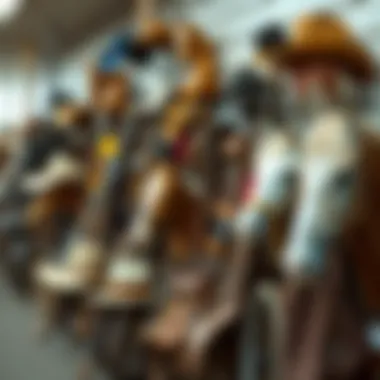
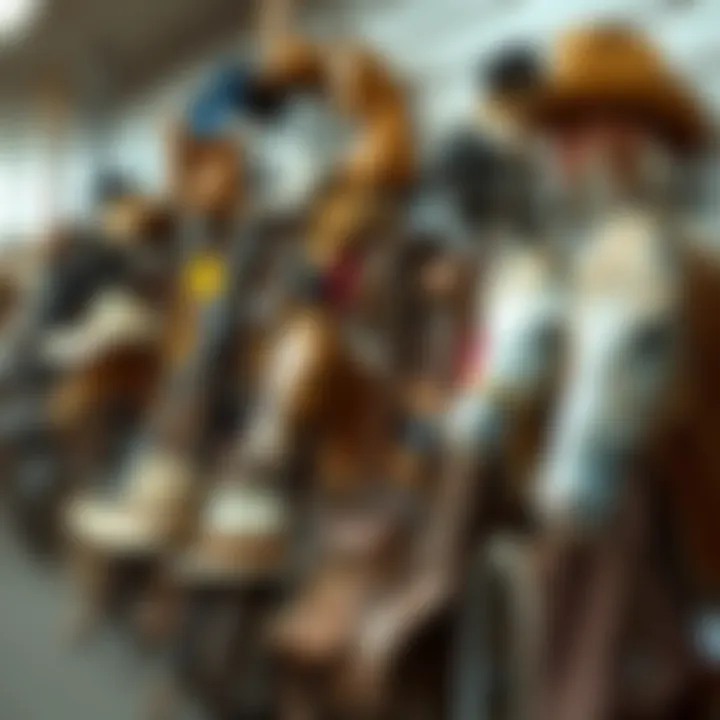
Intro
The world of rodeo is as vibrant and dynamic as the sport itself. For many enthusiasts, diving headfirst into this thrilling arena often means navigating the tricky waters of purchasing used rodeo gear. With budgets tightening and new gear prices skyrocketing, the secondhand market offers a treasure trove of opportunities for both seasoned cowpokes and newcomers to the roping and riding scene. But let’s face it, the used gear hunt is not just about saving a few bucks; it's about finding quality equipment that matches one’s style and needs.
In this guide, we will delve into the market for used rodeo gear, breaking it down into digestible sections that will arm you with the information necessary to make informed purchasing decisions. We'll discuss the different types of gear available, the nuances of evaluating secondhand items, and how to maintain your equipment to ensure it performs well when it really counts.
The aim is not just to save money but to empower you with knowledge so you can ride the waves of the rodeo world with confidence. Whether you are looking for a sturdy saddle, protective gear, or the perfect pair of spurs, understanding the landscape of used equipment is paramount. This comprehensive guide is here to help, from the basics of what gear to consider to the intricacies of maintenance and care, ensuring every decision aligns with your performance needs and budget constraints.
Now, let’s get into the nitty-gritty with some insights about the equipment!
Equipment Insights
When it comes to rodeo gear, the variety can be overwhelming. Different events call for different tools, and understanding what you need is half the battle. Let’s navigate through some essential segments of this fascinating landscape.
Different Types of Rodeo Gear
Rodeo gear can be categorized into several key types, each designed for specific purposes. Here’s a brief overview to get you oriented:
- Saddles: The heart of a good rider's equipment. Look for brands like Justin or Circle Y for used options that offer durability.
- Ropes: Essential for events like team roping or calf roping. A well-worn rope can have character but ensure it's not frayed.
- Spurs and Chaps: Often overlooked, these items enhance control and style. Check for functionality over just appearance.
- Protective Gear: Includes helmets and vests—don't skimp on safety, even in secondhand options.
Exploring trusted sources is key. Local rodeo events or forums on Reddit might be a gold mine for leads on where to find this gear.
Latest Gear Reviews
Before purchasing any used gear, it’s wise to research what's currently favored in the rodeo community. Websites like Facebook Marketplace are often buzzing with local sellers, and reading reviews through forums can provide solid insight. Pay attention to feedback on specific gear types; the experiences shared by others can inform your choices significantly.
Essential Gear Maintenance
Used gear, while cost-effective, requires diligent upkeep. Here's a basic maintenance checklist:
- Saddles: Clean with saddle soap, inspect for wear, and condition leather regularly.
- Ropes: Store in a cool place, check for kinks, and clean if necessary.
- Spurs and Chaps: Wipe down after each use, especially if mud or dirt is involved.
- Protective Gear: Inspect for any dents or wear and replace padding when needed.
Taking care of your gear not only extends its life but can drastically improve performance when you hit the dirt.
"Investing in quality, even secondhand, can mean the difference between a smooth ride and a rough tumble."
In subsequent sections, we will refine our focus from equipment to techniques, exploring how mastery of skills can elevate your rodeo experience.
Prelude to Used Rodeo Gear
Rodeo, a sport that embodies both tradition and thrill, is no small potatoes in the world of athletics. As the rodeo community continues to grow, so too does the market for used gear, providing a treasure trove of options for both seasoned cowboys and newcomers alike. Understanding the market for used rodeo gear is pivotal, as it can spell the difference between an exhilarating experience and a tough ride.
The significance of exploring the used gear market extends beyond mere savings, though. There’s a sense of community and sustainability sewn into the fabric of buying secondhand. For many, investing in used gear is not just frugality but a way of honoring the sport's rich history, while allowing for a variety of equipment options at more affordable prices.
When stepping into rodeo, having the right gear can bolster confidence and performance. Newcomers may find the initial costs overwhelming. This is where the used market shines; purchasing gear that has proven its worth can create pathways into the rodeo lifestyle without pulling at the purse strings too tightly.
A comprehensive guide to used rodeo gear is important to demystify the buying process, helping participants make informed choices about what to look for. Knowing the ins and outs of this market can enable buyers to seize the day without getting bogged down by bad decisions.
The Significance of Used Gear
Used gear plays a crucial role. Not only does it make rodeo accessible, but it often comes with character. Each saddle tells a story, and each rope carries whispers of past competitions. Additionally, opting for secondhand items is a deliberate nod towards environmental consciousness. This choice lessens waste and stimulates a cycle of reusability that feels right for both the shopper and the sport.
In essence, used gear is not simply about saving some bucks; it’s about embracing the heritage of rodeo. It gives life to the spirit of camaraderie, allowing experienced riders to share their gear and experiences with friends or youths trying to find their footing in this rough-and-tumble domaine.
Rodeo's Economic Landscape
The rodeo scene is more than just a series of competitive events; it's a booming economic landscape worth double-checking. According to various reports, the rodeo industry generates significant income, showcasing the hard work of both athletes and the businesses behind them.
First, consider the local economies around rodeo events. Small towns often thrive during rodeo season, with local businesses seeing spikes in sales as fans flock to town. This creates a chain reaction, leading to a boom in everything from gas stations to diners, reinforcing how interconnected the rodeo world is with everyday life.
Now, while the shiny new equipment often draws in attention, the used market provides an alternative route. Prices for new gear can run like a runaway steer, leaving a hole in one's budget. But the used market levels the playing field, introducing affordable options that allow more participants to join the fray. Riders can secure quality equipment that holds up under pressure, and in turn, can directly participate in the rodeo economy.
In summary, the exploration of the used rodeo gear market reveals a much larger economic framework at work. It not only emphasizes the importance of affordability and sustainability but also highlights the interconnectedness of rodeo culture and community. As we dive deeper into the types of used gear available, keep in mind the broader context in which these choices reside.
Types of Used Rodeo Gear
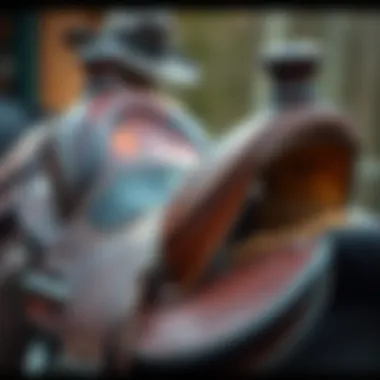
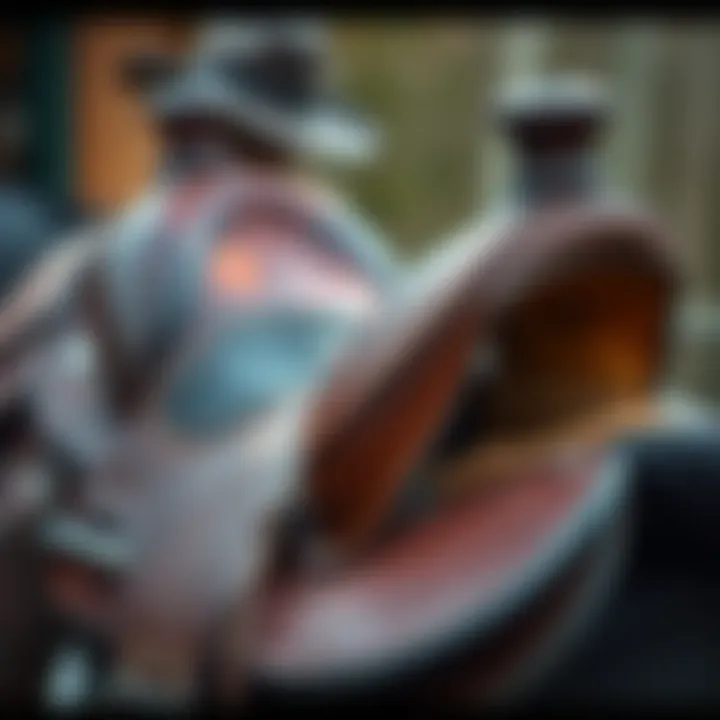
When diving into the world of used rodeo gear, understanding the different categories of equipment is crucial. Each piece plays a specific role, impacting not just the performance of the rider, but also the safety and comfort of both horse and rider. This section dissects the fundamental types of gear that make up a rodeo participant’s toolkit, helping both newcomers and seasoned veterans make informed choices.
Saddles and Tack
Types of Saddles
Saddles are the cornerstone of a rodeo participant's setup, crucial for both control and comfort. Understanding the varieties is key. Key characteristics like material, fit, and design can greatly influence both performance and safety. For instance, a rodeo saddle, often heavier, provides stability during intense maneuvers. In contrast, a barrel racing saddle, lightweight and designed for quick turns, is a popular choice among competitors aiming for speed.
Unique features such as horn design or seat padding can enhance rider experience significantly. The extra security a horn provides in team roping events is invaluable, but it may add unnecessary weight for those focusing on agility. Knowing these differences can help in making a choice that aligns with your riding needs.
Essential Tack Components
The tack plays an equally important role and can often be the unsung hero during competitions. Essential components include bridles, reins, and cinches, which all contribute to the overall functionality of the gear. A well-constructed bridle ensures clear communication between horse and rider, while the cinch must provide that snug fit without compromising the horse’s comfort.
One unique aspect of well-made tack is the material used. Leather, with proper care, offers durability and a classic touch, while synthetic materials might appeal for their maintenance ease. Advantages of quality tack are evident, but keep an eye out for wear; a fraying rein might not only impact your performance but also your safety.
Protective Gear
Vests and Helmets
Safety gear, though often overlooked, stands as a crucial element of rodeo gear. Vests and helmets serve to protect against falls and impact during competitions. These items come with various designs, and the right fit is paramount for effectiveness. A helmet that fits snugly but comfortably can mean the difference between minor bumps and serious injury.
The unique feature of modern vests is their lightweight design paired with high-impact materials. This balance allows for mobility while providing extensive protection. Riders often report added confidence, knowing they are better shielded from injuries, enhancing their overall performance.
Chaps and Gloves
Chaps keep legs protected from both abrasions and weather conditions. A quality pair of chaps specifically designed for rodeo can enhance grip, ensuring that the rider maintains their position on the saddle during intense rides. Though they come in varying styles and materials, leather remains a popular choice for its durability.
Gloves, on the other hand, enhance grip and warmth. Unique aspects like padded palms can cushion during long rides, while breathable materials prevent overheating. Seasoned riders often recommend that first-timers invest in a good pair, as they can significantly improve the comfort level during competitions.
Rodeo Accessories
Ropes
A good rope is more than just an accessory; it’s an essential tool in various rodeo events, especially in roping. Ropes come in different types, like lassos or team roping ropes, each with specific characteristics making them suited for differing scenarios. Weight, thickness, and flexibility can all play pivotal roles in the effectiveness of one’s technique.
The unique feature of high-quality ropes is often how they balance stiffness for quick throws while maintaining enough flexibility to allow for precision. Advantages include consistency in performance, which can make a significant difference during competitions.
Bucking Pads
When it comes to bucking broncos or bulls, the right pad makes all the difference. Bucking pads act as a cushion between the saddle and the animal, impacting both comfort and performance. Recognizing their importance can be essential for a successful ride.
Higher-quality pads typically feature materials that absorb shock effectively, which can protect both the rider and the animal. However, the drawback might be a higher price point, which is something to keep in mind when budget constraints are a concern.
Spurs
Spurs, while sometimes seen as a symbol of authority in the rodeo world, serve a practical purpose. They allow for subtle commands to a horse, providing clarity and enhancing ride communication. The key characteristic of spurs is their design; varying from blunt to sharp, they cater to different riding styles and preferences.
Choosing the right spurs can be a double-edged sword—while they can improve communication, misuse or overuse can lead to discomfort for the horse. Hence, opting for comfort-focused designs can contribute positively to the horse’s response and overall performance during competitions.
Where to Buy Used Rodeo Gear
Finding the right place to buy used rodeo gear can mean the difference between a fantastic deal and a regrettable purchase. The market is an intriguing blend of both physical and digital avenues; each has its own perks and pitfalls. Understanding where to look not only broadens your options but also ensures that you’re well-equipped to make smart choices, whether upgrading your gear or diving into the sport for the first time.
Online Marketplaces
Popular Websites
When it comes to buying secondhand rodeo gear, popular websites are often the starting point for many enthusiasts. Platforms like eBay, Craigslist, and Facebook Marketplace cater to a wide range of buyers and sellers, making it pretty convenient to explore available options. One of the main advantages these sites offer is the vast selection at your disposal; you can find everything from vintage saddles to recently used ropes.
However, you must tread carefully. Not all listings are created equal. The sheer volume of listings can sometimes be overwhelming. Additionally, one of the key characteristics of these popular websites is that verification of seller credibility can be a bit tricky. Often, you have to rely on user ratings and feedback, which may fluctuate.
Another unique feature is the option to negotiate directly with the seller via messaging—this can lead to better deals if you play your cards right. But watch out for potential scams; it’s always advisable to meet in public places and inspect the gear thoroughly before committing.
Social Media Groups
Social media groups, particularly on Facebook, have become a hub for buying and selling used rodeo gear. These groups often foster a community spirit, where members not only sell items but also share tips, experiences, and recommendations, offering a more personalized touch. The interactive nature of these groups can be beneficial. You can ask questions or even request specific types of gear from fellow members who may have leads.
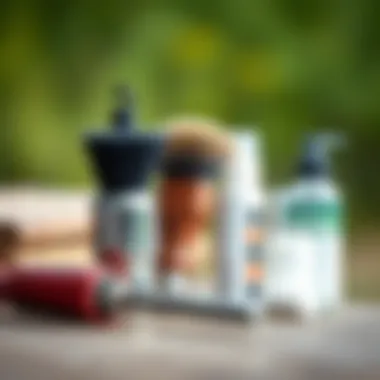
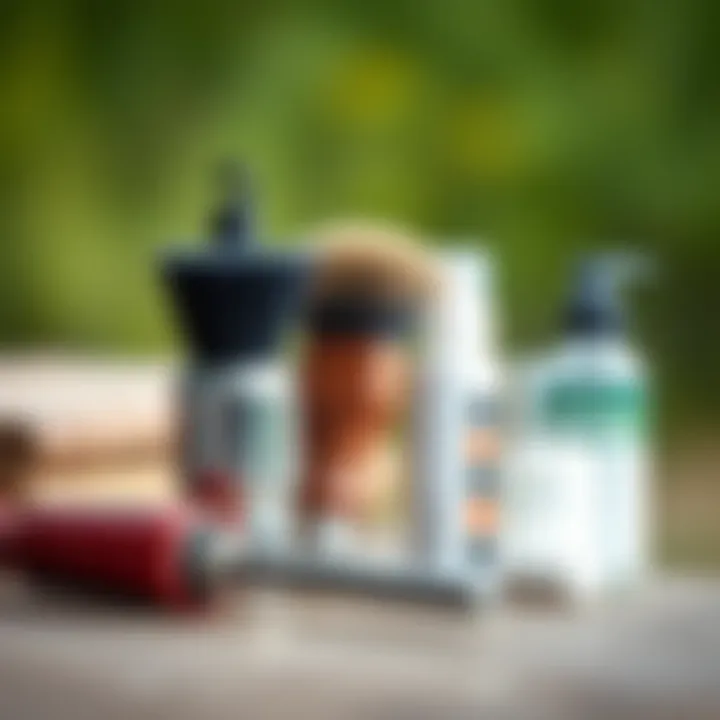
However, the downside is the variable quality of listings. Unlike established marketplaces, not all members follow set selling protocols, which may lead to inconsistency. Furthermore, while the community aspect adds warmth, it might require a bit more patience to sift through multiple posts to find the exact item you're after. If you find a deal, it’s usually quicker as some members may just want to move items fast.
Local Auctions and Sales
Local auctions and sales can be gold mines for purchasing used rodeo gear. These events often include a wide array of items, from saddles to bucking pads, resulting in unique finds that you may not see online. Plus, there’s the thrill of bidding, which can sometimes lead to obtaining quality gear at a sweetheart price.
Attending these local auctions allows you to thoroughly inspect items before bidding or buying, which can save you the hassle of dealing with misrepresented products later on. However, you need to be prepared; auctions often have a fast-paced environment, and it’s essential to set a budget beforehand to avoid conflicts with your wallet.
Specialized Rodeo Stores
Don’t overlook specialized rodeo stores, even if they may not focus on the secondhand market. Many have a corner for consignment items or trade-ins, which allows you to find solid gear at reasonable prices. Once you enter a specialized shop, owners or staff usually provide personalized assistance, helping you understand the nuances of what each piece of gear offers. It’s a more curated experience that can cater to your specific needs.
Moreover, purchasing from a specialized store may come with superior advice and knowledge regarding gear maintenance or updates. The downside, however, is that the selection might be limited compared to online options. Thus, if you have a specific item in mind, calling ahead could save you time and a trip.
Understanding where to buy used rodeo gear is vital for both new entrants and seasoned riders alike. Whether you prefer the convenience of online marketplaces, the interactive community in social media groups, the thrill of local auctions, or the personalized service in specialized stores, each offers valuable opportunities to find gear that suits your needs and budget.
Evaluating the Condition of Used Gear
When it comes to used rodeo gear, evaluating its condition holds substantial weight. Simply put, making an informed decision about your potential purchase directly affects your performance and safety in the arena. This section dives into how to scout for signs of wear and tear, assess structural integrity, and understand the implications of maintenance records. You wouldn't want to gear up with faulty equipment, as it could lead to mishaps that could have been avoided.
Inspecting Quality
Understanding Wear and Tear
Wear and tear refers to the gradual deterioration of equipment due to regular usage. It's essential to gauge this aspect because it reveals how much life is left in the gear you're eyeing. Look for features like fraying, cracks, or discoloration. These signals can be telling, not just about how much the item has been used, but also about how well it was maintained. For instance, a saddle that's been taken care of may show minimal wear despite being a few seasons old.
Recognizing the key characteristics of wear and tear allows you to negotiate better — if you spot evidence from a few rides on a pair of spurs, you can weigh that against the asking price. This makes understanding wear and tear a beneficial choice when shopping for used equipment.
Advantages of assessing wear include:
- Cost Savings: You might find a quality item for a fraction of the manufacturer’s price.
- Testing Durability: The condition can tell a story of its handling.
However, be cautious. Sometimes, issues like minor scuffs can be a façade for deeper, unseen damage. Knowing how to decifer these clues can save you some headaches down the line.
Identifying Structural Integrity
Structural integrity deals with the overall sturdiness of the gear. This includes examining the foundation, stitching, and any attached components. Don’t assume that just because gear looks decent on the outside, it’s sound on the inside. Take saddles, for instance — an apparent scratch might merely be a cosmetic issue, while a cracked tree could mean a complete loss of stability.
A close inspection should include looking under the neck for signs of warping and checking the seams for any loose stitching. The key characteristic of good structural condition is, of course, reliability. The last thing you'd want during a competitive ride is to discover that your tackle won't hold up under pressure. Knowing how to evaluate structural integrity is imperative for safe and effective use.
Benefits of understanding structural integrity are:
- Safety Assurance: A well-maintained piece of gear allows for a safe ride without unexpected breakage.
- Investment Longevity: Items with great structural integrity will likely last longer, ensuring a better return on your investment.
On the flip side, failing to assess this can lead to financial loss or, worse, serious accidents. Don't overlook this step; it's about protecting your wellbeing and elevating your performance in the arena.
Importance of Maintenance Records
Maintenance records provide a paper trail of how the gear has been used and cared for over time. A piece of gear with a documented history of regular upkeep can offer peace of mind. In contrast, a lack of records might leave you guessing about its prior handling. Having maintenance history can highlight how much work has gone into the gear's care — has it been serviced regularly, or has it been left in a barn corner for ages?
Consulting the maintenance records can also aid in evaluating its potential lifespan. If a rodeo jacket, for example, was cleaned and treated regularly, it's likely to have a few more good rides left in it than one that has been neglected. It’s akin to knowing the service history of a used car; it can reveal underlying problems you may need to consider.
Remember, a well-documented maintenance record can also support your bargaining position. If someone has failed to keep a horse collar clean, you might deduce it's not worth its asking price.
Investing time in evaluating these elements ensures you’re not only satisfying your immediate needs but also making informed choices that can lead to long-term benefits in your rodeo endeavors.
Negotiating Prices and Making Offers
Negotiating prices when purchasing used rodeo gear is not just a strategy; it's an essential skill that can dramatically affect your overall expenses. In an environment where the quality and condition of equipment significantly vary, understanding how to negotiate effectively can save you a princely sum without compromising on the gear's functionality or safety. Furthermore, honing your negotiation skills fosters a deeper connection with the rodeo community, allowing you to establish trust and rapport with sellers.
Researching Market Values
Before stepping onto the negotiation field, it’s vital to do your homework. Researching current market values for used rodeo gear can provide invaluable insight into fair pricing. By familiarizing yourself with the typical prices on various platforms, you can enter conversations equipped with facts, rather than relying solely on instincts. This preparation will help you gauge whether the seller's price is in line with market standards.
A few practical tips can aid in your research:
- Online Marketplaces: Websites such as eBay, Craigslist, and specialized rodeo forums can showcase the asking prices of similar items. Compare these to get a better grasp of your potential gear’s worth.
- Community Insights: Engage in discussions on platforms like Reddit or Facebook groups focused on rodeo enthusiasts. Fellow riders usually have firsthand experience and can share knowledge about what is reasonable or whether prices are inflated.
- Seasonal Variations: Be aware that prices can fluctuate based on the season—demand may soar during rodeo season, prompting sellers to raise prices. Understanding these dynamics can inform your approach.
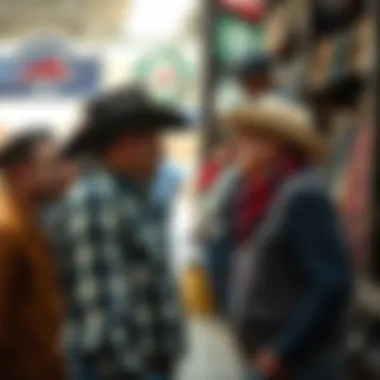
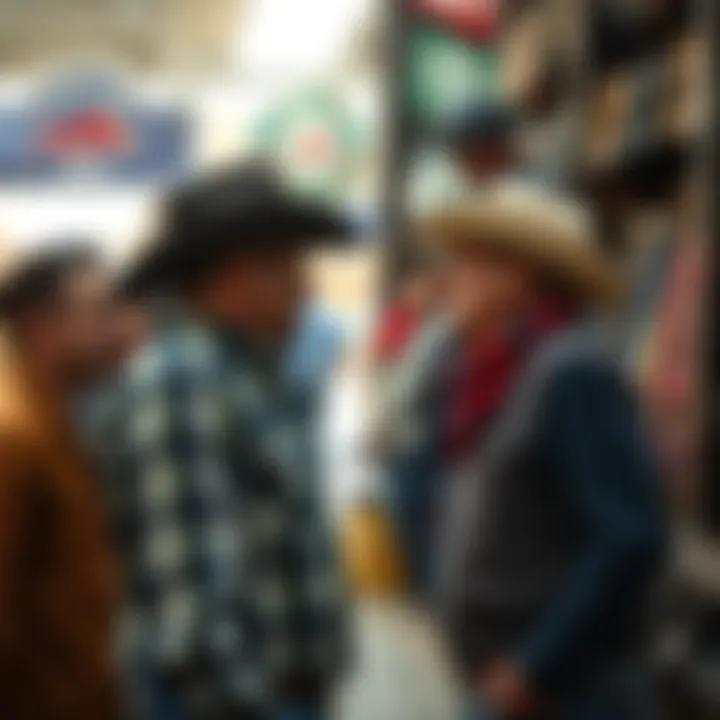
By doing so, you'll be armed to challenge a price if necessary, reinforcing your position in negotiations.
Best Practices in Negotiation
Once you're ready to engage in negotiations, comprehension of tactics can make a world of difference. Skilled negotiation isn't about pressure; it's about compromise and creating win-win situations. Here are some best practices to keep in mind:
- Start with a Lower Offer: Initiate the conversation with a reasonable offer below what you’re willing to pay. This tactic can create a buffer to allow for negotiation leeway, presenting an opportunity for adjustments from both sides.
- Ask Open-Ended Questions: Questions like, "What’s the best price you can offer?" or "Is there any room to negotiate?" can invite the seller to share their thoughts, which often yields useful information.
- Be Prepared to Walk Away: If the price doesn’t suit your budget or the conditions of the gear are lacking, be willing to step back. This assertiveness communicates to the seller that you have alternative options.
- Express Genuine Interest: Building rapport can go a long way. Share your experiences or interest in rodeo, showing the seller that you're not just another buyer but someone who appreciates quality gear.
- Don’t Rush: Take your time during the back-and-forth process. Rushing can signal desperation and may lead to a worse deal.
"Negotiation is not about being tough. It’s about being smart."
By practicing these negotiation strategies, you can navigate the discussions with confidence and clarity, ensuring your purchase aligns with both your needs and your budget.
Caring for Used Rodeo Gear After Purchase
Caring for used rodeo gear post-purchase is not just about maintaining appearances; it's essential for ensuring that your equipment performs at its best and lasts for many rodeos to come. In a sport where safety and reliability are paramount, understanding how to clean, maintain, and store your gear can be the difference between a successful ride and a mishap. With the right care, your used equipment can serve you well and withstand the rigors of rodeo life.
Cleaning Techniques
Keeping your rodeo gear clean is vital. The dirt, sweat, and grime that accumulate from riding can deteriorate the materials over time. Here are some effective techniques:
- Leather Gear: For saddles, bridles, and other leather items, use a soft brush to dust off dirt and debris. After that, apply a leather conditioner to keep the material supple and avoid cracking. Just remember, a little goes a long way!
- Fabric Vests and Chaps: For fabric items, check the label for washing instructions. Most can be washed on a gentle cycle, but make sure to air dry them to prevent shrinking. If they’ve got stubborn stains, pre-treat them with a fabric-safe stain remover before washing.
- Protective Helmets: Wipe them down with a damp cloth after each use. Avoid submerging them in water, as this might compromise the internal padding. They also need some air time—store them in a well-ventilated area to avoid mildew.
"The upkeep of your gear can make the difference between comfort and disaster in the heat of competition."
Keeping your gear clean doesn’t just prolong its life; it also provides peace of mind. Dirty equipment can harbor bacteria and odors, potentially distracting you during a ride.
Storage Recommendations
Where and how you store your rodeo gear can dramatically affect its longevity. Here are some best practices for storing your gear:
- Dry Environment: Always store your gear in a dry place to prevent mold and mildew growth. Moisture is the enemy, especially for leather items.
- Cool Temperatures: Extreme heat can warp saddles and helmets, while frigid conditions might damage them as well. A climate-controlled environment is best, even if that means investing in a small storage unit.
- Use of Covers or Bags: When you're not using your gear, cover it with breathable fabric covers or place it in padded storage bags designed for rodeo equipment. This keeps dust off while avoiding moisture buildup.
- Organizing: Keep gear organized in a way that prevents crushing or bending. Saddles should be hung or stored flat, while chaps can hang freely to maintain their shape. Consider wall racks or dedicated bins for smaller items.
By implementing these practices, you’ll safeguard your investment and ensure that your used rodeo gear is ready for action whenever you are. Remember, a little care goes a long way in preserving not just the life of the gear, but also your success in the ring.
Selling Used Rodeo Gear: Tips and Guidelines
When considering the world of used rodeo gear, many people don’t just look at purchasing; they also think about selling. This part of the equation is just as crucial, whether you're a competitor upgrading to the latest styles or a new seller trying to enter the market. By focusing on selling strategies, you can not only recoup some of your investment but also help others find the right gear at affordable prices. Learning how to sell secondhand gear effectively can ease others’ entry into the rodeo community while putting a few bucks back in your pocket.
Preparing Gear for Sale
Before you can hang that "For Sale" sign, the first step is getting your gear ready. Here are key points you should consider:
- Detail Inspection: Carefully examine each piece of equipment. Look out for any wear and tear because potential buyers will be much keener than you might think. It is wise to check for frays in ropes, cracks in saddles, or any impact on helmets.
- Clean and Refresh: Nothing shouts "I care" quite like a nicely cleaned item. Give your gear a good scrub. Use saddle soap on leather items and check the manufacturer's recommendations for cleaning synthetic materials. A clean product shows that it's been cared for and is more likely to fetch a good price.
- Document Maintenance: If you've kept records of maintenance or repairs, even better! Share this information when selling, as it adds credibility. A well-documented history can convince a buyer that they are making a solid investment.
- Set a Fair Price: Research similar items in the market to find out what similar gear goes for. Websites like Craigslist or local listings can give you an idea. It’s important to balance what you feel the item is worth with what others are willing to pay.
Crafting Effective Listings
Now that you've prepared your rodeo gear for sale, it's time to write the listing. An effective listing is crucial in attracting potential buyers and ensuring a swift sale:
- Descriptive Titles: Your title should grab attention and be specific. Instead of just "Rodeo Saddle for Sale!", try something like "High-Quality Leather Rodeo Saddle - Well-Maintained". That extra detail can draw in more interest.
- Include Key Details: Make sure to include all pertinent details in the listing. Mention the brand, size, model, and condition. Use bullet points for clarity. Here’s a quick checklist:
- Quality Photographs: High-resolution images can make all the difference. Showcase your gear from multiple angles in good lighting. Be honest with the images: if there’s a scratch, show it! Buyers appreciate transparency.
- Answer Inquiries Promptly: Be ready to respond to questions as they come. Quick responses reflect professionalism and can help close the deal faster. Don’t shy away from negotiating, as flexibility can often make a sale happen.
- Brand and Model
- Size (if applicable)
- Condition (new, gently used, etc.)
- Maintenance history and any included accessories
A well-crafted listing not only attracts buyers but also sets the tone for the transaction. Your gear becomes a story, not just an item to push off.
Selling used rodeo gear can be a rewarding venture if approached correctly. Following these tips can help create a positive experience for both you and the buyer, ensuring that rodeo enthusiasts can enjoy your gear for years to come. Consider joining relevant communities on platforms like Facebook or Reddit to reach potential buyers actively seeking what you're offering.
Finale
When it comes to navigating the realm of used rodeo gear, understanding the landscape is key. This guide provides a thorough examination of the various elements related to purchasing, evaluating, and eventually selling used items. The ultimate goal for both seasoned veterans of the rodeo circuit and newcomers is to find reliable equipment that doesn't stretch their wallets too thin.
Summarizing Key Takeaways
Several important points emerge from our discussions:
- Diverse Options: Whether it's saddles, protective gear, or accessories, it's clear that the used market has a variety of choices.
- Condition Matters: The quality of used gear is paramount. Knowing how to inspect and assess items before purchase can save money and enhance safety.
- Negotiation Skills: Being prepared to haggle can lead to better deals, emphasizing the importance of market research.
- Care and Maintenance: Proper upkeep of used gear not only extends its lifespan but can significantly affect performance.
- Timely Selling: When it's time to sell, understanding how to prepare and market used gear effectively can ensure good returns.
Future Trends in Rodeo Gear
Looking ahead, several trends appear on the horizon for used rodeo gear:
- Sustainability Focus: As environmental concerns continue to rise, a growing emphasis on second-hand equipment is likely to encourage more rodeo enthusiasts to opt for used items rather than new, purchasing gear that reflects sustainability.
- Online Marketplaces Growth: Platforms like Facebook Marketplace and specialized websites dedicated to rodeo gear are expanding. This evolution in digital commerce offers buyers and sellers alike more convenient access to a broader audience.
- Technology Integration: New technologies for gear evaluation could emerge. This may include apps providing condition assessments or historical pricing tools, aiding buyers in making informed decisions.
- Customization Preferences: With certain used items, there's potential for consumers to seek customizations in gear that may not often be found in new products, personalizing them for enhanced comfort and performance.
Learning and adapting to these changes can lead to informed purchasing decisions and a better overall rodeo experience.







